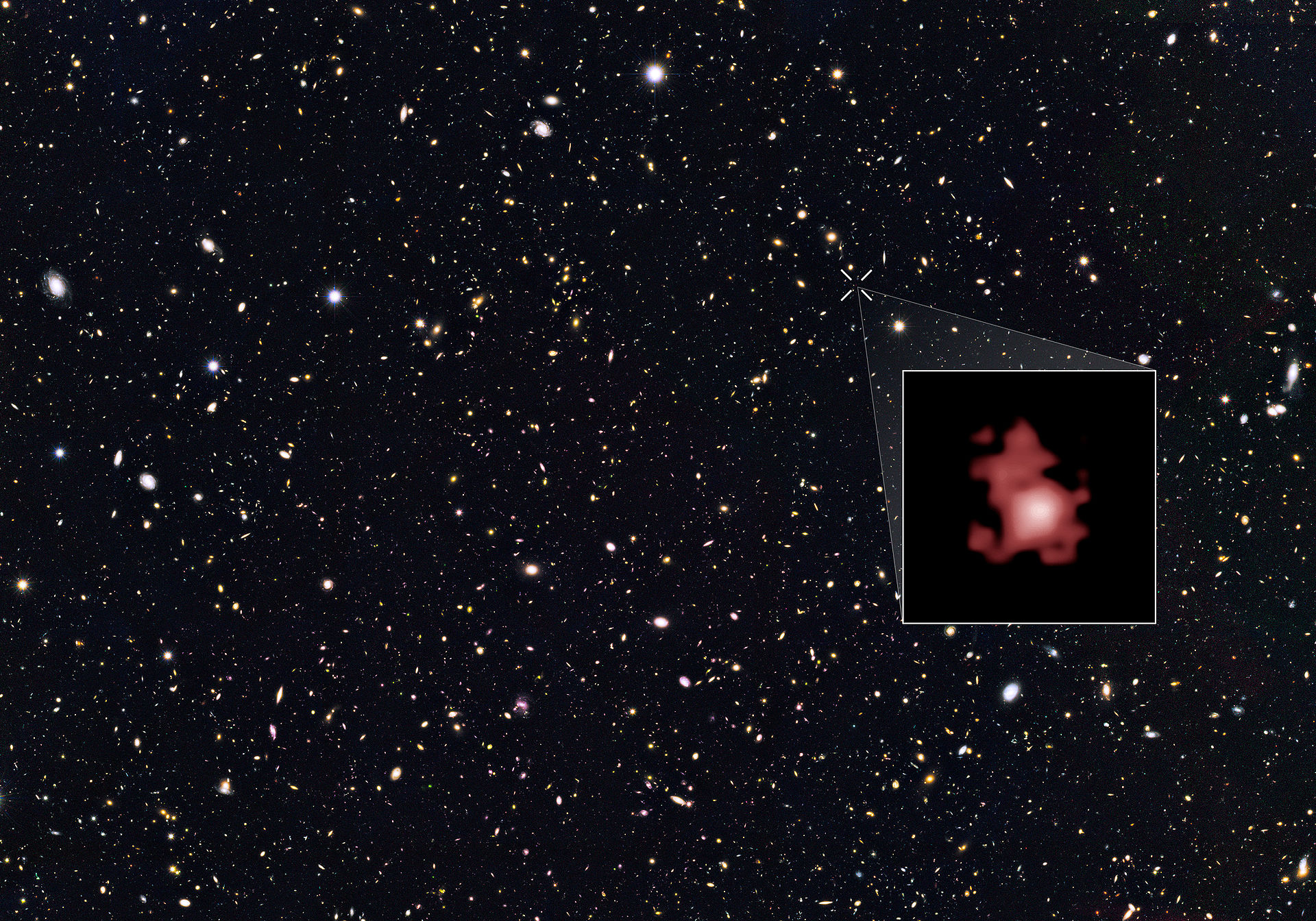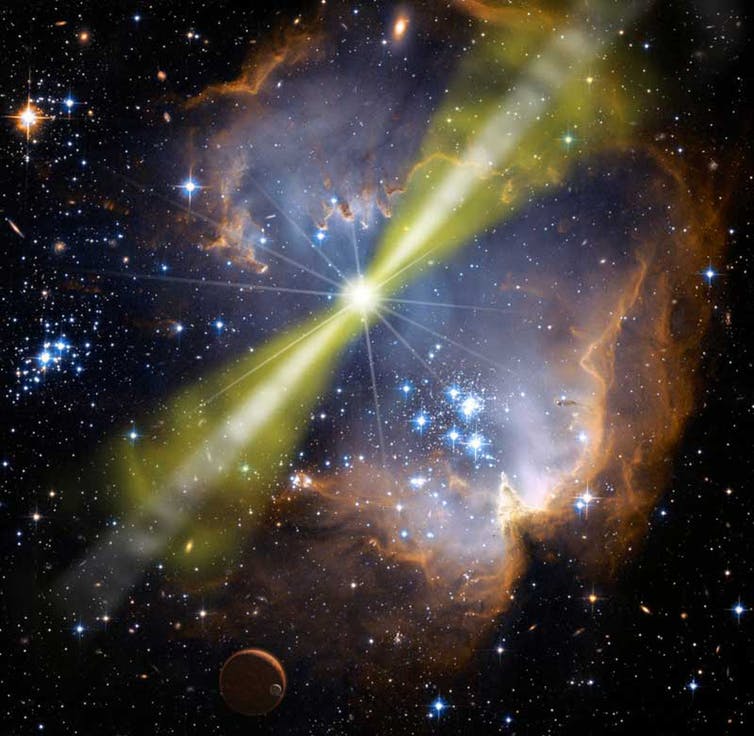The oldest gamma-ray burst ever discovered was just a piece of space junk
A sudden brightening in observations of the oldest known galaxy has a rather disappointing explanation.

Sometimes a flash is just a fluke.
A signal that scientists first believed was the ground-breaking discovery of a gamma-ray burst from the oldest known galaxy in the universe was in fact a reflection of sunlight from a spent rocket stage in Earth's orbit, a new paper has found.
The disappointing conclusion comes from a team of Polish scientists following a discussion involving several teams about the origin of the serendipitous sighting made by one of the twin Keck telescopes in Hawaii in 2017. Whereas previous contributions to the debate focused on the probability of seeing a satellite compared to an extremely rare gamma-ray burst, the Polish team managed to track down the exact object that caused the flash — a spent Breeze-M upper stage from a Russian Proton rocket.
"We checked our calculations against three other publicly available orbit calculation software," Michal Michalowski, an astronomer at the Adam Mickiewicz University in Poland and lead author of the new study, told Space.com.
So what exactly did the Keck telescope see and how is it even possible to mistake the most powerful flash of light in the universe taking place billions of light-years away for sunlight reflecting off a piece of space junk?
Related: Astronomers catch fizzled-out gamma-ray burst from supernova
A chance sighting
The team behind the original observation, led by scientists from the University of Beijing in China, set out to study one of the oldest galaxies in the universe. Known as GN-z11, the galaxy is more than 13 billion light-years away from Earth. That means telescopes can only see it as it looked some 420 million years after the Big Bang, when the universe was very young.
Breaking space news, the latest updates on rocket launches, skywatching events and more!
The team used a near-infrared spectrograph called MOSFIRE mounted on one of the Keck telescopes. Instead of capturing images, the spectrograph measures the brightness of a celestial object at specific wavelengths of light. The team was taking three-minute measurements of GN-z11 when suddenly, the galaxy lit up. Within the next three minutes, however, the signal was back to normal.
After ruling out other possibilities, the scientists concluded that the sudden brightening must have been a gamma-ray burst, the brightest and most energetic flash of light in the universe believed to be produced by explosions of massive stars at the end of their lives, which astronomers call supernovas. Lasting only a few seconds, gamma-ray bursts briefly outshine everything else in the surrounding cosmos. But tracing their origins has so far been elusive.
The team published their findings in the journal Nature Astronomy last December. The discovery seemed like a big deal. Scientists have never observed a gamma-ray burst in such an old galaxy, and seeing one would reveal new information about the early universe.
Too elusive
However, other astronomers soon started to question the findings, and two papers published Monday (Oct. 4) in the journal Nature Astronomy lay out what went wrong.
In one, Charles Steinhardt, associate professor of astronomy at the University of Copenhagen in Denmark, and his colleagues argued that the brightening was likely caused by an object orbiting Earth rather than a chance sighting of a rare gamma-ray burst. The reason: probability.
"The probability of catching a gamma-ray burst like this is incredibly low, something like 1 in 10 billion," Steinhardt told Space.com.
Astronomers estimate that although satellites spot about one gamma-ray burst per day, roughly 500 are occurring within the same time period. However, in most cases, scientists have no idea no idea which galaxies these bursts came from.
"The big gamma-ray telescopes that we use to detect gamma-rays only tell you that a burst went off and give you the rough region of the sky where that happened," Steinhardt said. "If you want to know the exact galaxy, you would have to point an optical telescope at that region quickly enough to catch the flash and find its source. But you only have a maximum of 100 seconds to do that."

The odds
To catch a gamma-ray burst in the oldest known galaxy during a random imaging campaign seemed a bit too lucky. Steinhardt and his colleagues therefore looked for other explanations, including reconsidering those ruled out by the Chinese team. The scientists trawled the MOSFIRE archives and found dozens of similar occurrences in other observations.
"When we looked at the signal of the brightening, it actually didn't look like any of the 10,000 gamma-ray bursts detected before," Steinhardt said. "It looked more like a typical star, for example our sun. So that might include everything that reflects sunlight."
In the original paper, the Chinese team claimed a reflection from a satellite couldn't have caused the brightening. The scientists wrote that they checked against available orbital information of known satellites and pieces of debris and didn't find an object whose trajectory would have matched the sighting. The astronomers also wrote that it would be extremely unlikely for a satellite or a piece of debris to interfere with observations like that. But the results of Steinhardt and his colleagues give a more favorable probability for such an incident to occur — about one in 1,000.
"If you have a probability of catching a satellite like this one in a 1,000 versus a one in a billion probability of catching a gamma-ray burst, it is clearly 1 million times more likely that you have caught a satellite," Steinhardt said.
Images from optical telescopes streaked with trails of orbiting satellites have been in the spotlight recently as astronomers call for restrictions on satellite megaconstellations such as SpaceX's Starlink internet-beaming project. The smears are obvious and their source unmistakable. In case of spectroscopic measurements, however, picking out the noise is much more challenging.
Tracking down the culprit
"It's very difficult to distinguish that in spectroscopy," Michalowski said. "The spectrograph takes in the light through a very narrow slit. The satellite is outside of the slit and then it is suddenly inside of it for a very short moment, there is no trail leading up to it."
Michalowski and his team, spurred by Steinhardt's estimates, tracked down the actual source of the brightening by searching the publicly available Space-Track database of orbiting objects. The Breeze-M upper stage circling Earth in a highly elliptical orbit was exactly at the right place at the right time, Michalowski said
Interestingly, the Chinese team had originally excluded this rocket stage based on calculations using the web-based astronomical calculator called Calsky. But Michalowski is confident that their calculations were wrong.
"It's hard to say why the original calculation differed," he said. "The software that the team used is now down so it's impossible to reproduce that. Our calculations match four others so we are fairly confident that we got it right."
A growing problem in astronomy
The conundrum highlights a growing problem in astronomy: the increasing number of satellites and space debris objects in orbit interferes with astronomical observations and the exploration of the universe. A recent study estimated that up to 40% of astronomical observations with wide-field telescopes could be ruined after SpaceX deploys all of the currently planned 12,000 satellites of its Starlink constellation.
The solution, according to Michalowski, is not easy. "There are countless examples even now where satellites cross images, and it will only get worse," Michalowski said. "The only solution is to observe these satellites and determine their orbits more accurately so that we create a very precise catalogue that will help tell us whether something was actually an astronomical event or a passing satellite."
Steinhardt agreed. "If we had a good database, if we knew that a satellite or a piece of debris was going to pass through that part of the sky in that particular second, we would have stopped the observations for that second, waited for it to pass by, and then started the next exposure," he said. "The reason that didn't happen is that right now, we don't have the right database or the right toolkit."
Follow Tereza Pultarova on Twitter @TerezaPultarova. Follow us on Twitter @Spacedotcom and on Facebook.

Tereza is a London-based science and technology journalist, aspiring fiction writer and amateur gymnast. Originally from Prague, the Czech Republic, she spent the first seven years of her career working as a reporter, script-writer and presenter for various TV programmes of the Czech Public Service Television. She later took a career break to pursue further education and added a Master's in Science from the International Space University, France, to her Bachelor's in Journalism and Master's in Cultural Anthropology from Prague's Charles University. She worked as a reporter at the Engineering and Technology magazine, freelanced for a range of publications including Live Science, Space.com, Professional Engineering, Via Satellite and Space News and served as a maternity cover science editor at the European Space Agency.
